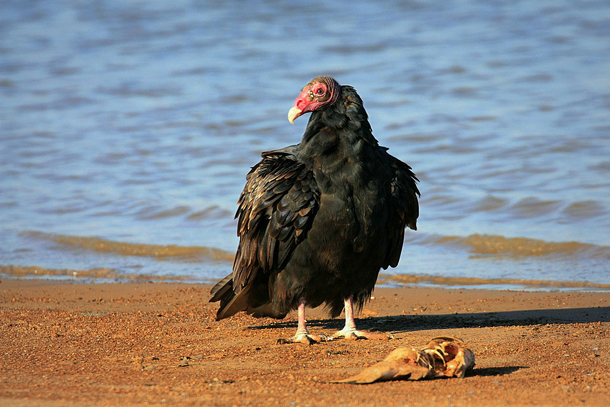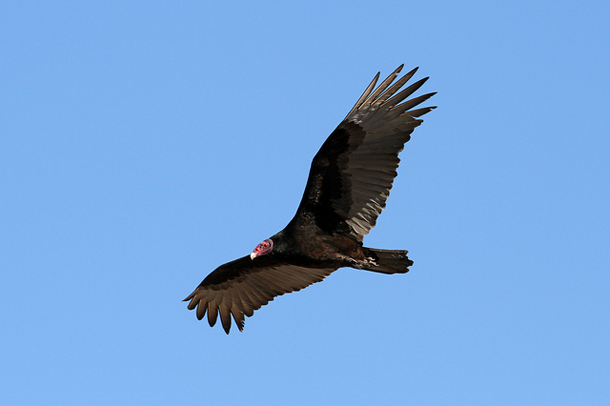BirdNote®: A Big Black Gas Leak Detector
Air Date: Week of June 19, 2015

Turkey Vultures belong to the raptor family. They provide important ecosystem services: eating animal carcasses. This helps to minimize the spread of disease to other animals and regions. (Photo: Ken Slade)
Identifying natural gas leaks from pipelines is important, but with over 300,000 miles of pipe in US, the task can be a daunting one. But as BirdNote®’s Mary McCann reports, a serendipitous tip from an oil worker helped an ornithologist solve mysteries about turkey vultures’ scavenging behavior and interest in gas lines.
Transcript
[MUX - BIRDNOTE® THEME]
CURWOOD: Birds that feast on carrion send shivers down the spine for many of us, even though they perform a beneficial role in recycling organic matter. And as Mary McCann explains in today’s BirdNote®, there is another useful function that turkey vultures seem able to perform.
BirdNote® Turkey Vultures and Gas Pipelines
MCCANN: In the late 1950s, scientist and ornithologist Kenneth Stager set out to answer, once and for all, a question that has been argued over for decades. Do vultures detect carrion by sight or by smell?
The story goes that his lightbulb moment came when a Union Oil employee told him of vultures congregating at the spots along pipelines where gas leaks were occurring. Why would they do that? Well, because a key ingredient in the odor of carrion is ethyl mercaptan — the same substance companies added to odorless natural gas in their pipelines, so they could smell if there was a leak. With just about the keenest sense of smell in nature, Turkey Vultures can detect this odor in the air at even a few parts per trillion.

Turkey Vultures are foragers that eat carrion, decaying animals. Flying slowly and at low altitudes helps them locate carrion. (Photo: Jamie Chavez FCC)
So Stager rigged up a mercaptan-emitting machine, took it into the field, and recorded his results. Definitively, he proved that vultures find their prey because of its smell.
Today, there are more sophisticated ways to track pipeline leaks. But who knows? … Now and again, a watchful worker may just cast an eye upward, on the lookout for ominous silhouettes slowly circling against the blue sky.
I am Mary McCann.
###
Written by Bob Sundstrom
Bird sounds provided by The Macaulay Library of Natural Sounds at the Cornell Lab of Ornithology, Ithaca, New York. Desert ambience: “002 Wind Mod Soft” and “132 Desert Morning Bird Chorus” Nature SFX recorded by Gordon Hempton of QuietPlanet.com
BirdNote’s theme music was composed and played by Nancy Rumbel and John Kessler.
Producer: John Kessler
Executive Producer: Dominic Black
© 2015 Tune In to Nature.org June 2015 Narrator: Mary McCann
Key source: http://davidhaviland.com/?p=13]
Also: http://www.allaboutbirds.org/guide/Turkey_Vulture/lifehistory
http://www.bedfordaudubon.org/birds/vultures01.html
https://baynature.org/articles/comes-smell-turkey-vulture-stands-nearly-alone/
Links
Living on Earth wants to hear from you!
Living on Earth
62 Calef Highway, Suite 212
Lee, NH 03861
Telephone: 617-287-4121
E-mail: comments@loe.org
Newsletter [Click here]
Donate to Living on Earth!
Living on Earth is an independent media program and relies entirely on contributions from listeners and institutions supporting public service. Please donate now to preserve an independent environmental voice.
NewsletterLiving on Earth offers a weekly delivery of the show's rundown to your mailbox. Sign up for our newsletter today!
 Sailors For The Sea: Be the change you want to sea.
Sailors For The Sea: Be the change you want to sea.
 The Grantham Foundation for the Protection of the Environment: Committed to protecting and improving the health of the global environment.
The Grantham Foundation for the Protection of the Environment: Committed to protecting and improving the health of the global environment.
 Contribute to Living on Earth and receive, as our gift to you, an archival print of one of Mark Seth Lender's extraordinary wildlife photographs. Follow the link to see Mark's current collection of photographs.
Contribute to Living on Earth and receive, as our gift to you, an archival print of one of Mark Seth Lender's extraordinary wildlife photographs. Follow the link to see Mark's current collection of photographs.
 Buy a signed copy of Mark Seth Lender's book Smeagull the Seagull & support Living on Earth
Buy a signed copy of Mark Seth Lender's book Smeagull the Seagull & support Living on Earth

